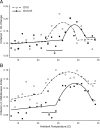Effects of estradiol on the thermoneutral zone and core temperature in ovariectomized rats
- PMID: 20051485
- PMCID: PMC2840690
- DOI: 10.1210/en.2009-1112
Effects of estradiol on the thermoneutral zone and core temperature in ovariectomized rats
Abstract
Hot flushes represent a disorder of central thermoregulation characterized by the episodic activation of heat loss mechanisms. Although flushes are associated with estrogen withdrawal, there is little understanding of the effects of estrogen on thermoregulation in any species. It has been proposed that hormone withdrawal increases the sensitivity of hypothalamic neural pathways that control heat dissipation effectors. If so, we predicted that ovariectomized rats without estradiol treatment would activate tail skin vasodilatation (a major heat loss effector) at lower ambient temperatures and thereby lower the thermoneutral zone. The thermoneutral zone, defined as the range of ambient temperatures in which thermoregulation is achieved only by sensible (dry) heat loss, was evaluated based on properties of skin vasomotion. Core and tail skin temperatures were recorded in ovariectomized rats (with and without estradiol-17beta) exposed to ambient temperatures from 13 to 34 C in an environmental chamber. Rats without estradiol exhibited increased skin vasodilatation and a shift in the thermoneutral zone to lower ambient temperatures. Moreover, the ambient temperature threshold for skin vasodilatation was significantly lower in rats without estradiol treatment. At most ambient temperatures, average core temperature was unaffected by estradiol. However, at ambient temperatures of 32.5 C and above, untreated ovariectomized rats exhibited higher core temperatures compared with estradiol-treated rats. Thus, estradiol-17beta treatment enhanced the maintenance of core temperature during heat exposure. These findings support the hypothesis that estrogen withdrawal increases the sensitivity of thermoregulatory neural pathways and modifies the activation of heat loss mechanisms.
Figures


References
-
- Stearns V, Ullmer L, López JF, Smith Y, Isaacs C, Hayes D 2002 Hot flushes. Lancet 360:1851–1861 - PubMed
-
- Santoro N 2008 Symptoms of menopause: hot flushes. Clin Obstet Gynecol 51:539–548 - PubMed
-
- Deecher DC, Dorries K 2007 Understanding the pathophysiology of vasomotor symptoms (hot flushes and night sweats) that occur in perimenopause, menopause, and postmenopause life stages. Arch Womens Ment Health 10:247–257 - PubMed
-
- Freedman RR 2001 Physiology of hot flashes. Am J Human Biol 13:453–464 - PubMed
-
- Kronenberg F 1994 Hot flashes: phenomenology, quality of life, and search for treatment options. Exp Gerontol 29:319–336 - PubMed

